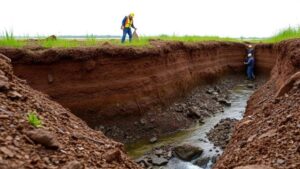Advanced Geological Modeling for Predicting High-Potential Silver Zones
Advanced Geological Modeling for Predicting High-Potential Silver Zones
In the realm of mineral exploration, particularly for precious metals, advanced geological modeling plays a critical role in identifying high-potential silver zones. This article explores various methodologies and technologies employed in geological modeling, their efficacy in predicting silver deposits, and real-world applications that highlight their significance.
The Importance of Geological Modeling
Geological modeling serves as the backbone of exploration strategies in mining. Through integrating various data sources, geologists can create predictive models that not only identify potential silver zones but also minimize the financial risks associated with exploration. A study conducted by the United States Geological Survey estimates that effective geological modeling can improve the success rate of mineral exploration by as much as 30%.
Data Integration Techniques
Modern geological modeling relies on integrating vast datasets from different sources. This includes:
- Geological maps
- Geochemical assays
- Geophysical surveys
- Remote sensing data
- Historical exploration data
The amalgamation of these data sets allows for the construction of a more comprehensive model. For example, in the case of a silver exploration project in Nevada, integrating geochemical assays with geophysical data enabled geologists to delineate mineralized zones that traditional methods would have overlooked.
Modeling Techniques and Software
Different modeling techniques are available, each suitable for specific geological conditions:
- Geostatistical Modeling: Uses statistical methods to analyze the spatial distribution of mineral deposits. Tools like GSLIB and SGeMS are commonly used for kriging analyses which predict silver concentration in undeveloped regions.
- 3D Geological Modeling: Software such as Leapfrog Geo allows for a three-dimensional visualization of geological structures, facilitating a better understanding of how silver deposits may be situated within various rock types.
- Machine Learning Algorithms: Increasingly used to identify patterns in large datasets. Algorithms can be trained on existing deposit data to predict new locations that might harbor high-grade silver.
For example, in a recent project in Mexico, machine learning techniques were deployed to analyze drill hole data, identifying previously unknown silver zones with an accuracy rate of over 85%.
Case Studies Illustrating Success
Several successful explorations underscore the effectiveness of advanced geological modeling in predicting silver zones:
- Sierra Madre Occidental, Mexico: Here, a combination of geological mapping and geochemical analysis led to the discovery of multiple high-potential silver veins, resulting in a significant increase in silver reserves for several mining companies.
- Pan American Silver, Peru: Utilizing 3D geological modeling, this company successfully expanded its resource base in the region by uncovering new high-grade silver deposits that were initially obscured by complex geological formations.
Challenges in Geological Modeling
Despite its advantages, geological modeling is not without challenges. Among these are:
- Data Quality: Inaccurate or incomplete data can lead to misguided predictions. Ensuring data integrity is crucial.
- Complex Geology: When geological formations are highly intricate, modeling can become more complicated, requiring innovative approaches to accurately visualize structures.
- Cost of Technology: Advanced modeling software and tools can be expensive, presenting a barrier to smaller exploration companies.
Addressing these challenges requires collaboration among geologists, data scientists, and software engineers to create robust models that can withstand scrutiny from stakeholders.
Future Trends in Geological Modeling
As technology evolves, the future of geological modeling looks promising. Innovations such as artificial intelligence and enhanced remote sensing techniques are likely to increase the accuracy and efficiency of predicting high-potential silver zones. Also, advancements in cloud computing will enable better collaboration and data sharing among exploration teams, making modeling processes more dynamic and adaptable to changing field conditions.
Actionable Takeaways
For mining companies and exploration geologists aiming to enhance their predictive capabilities for silver deposits, consider the following:
- Invest in robust geological data collection and integration techniques.
- Use diverse modeling software that fits the specific geological context of your exploration area.
- Foster interdisciplinary teams combining geological expertise with data science and engineering.
- Stay updated on technological advancements that could enhance modeling accuracy.
By focusing on these strategies, mining companies can significantly increase their chances of discovering high-potential silver zones, ultimately leading to successful exploration outcomes.


